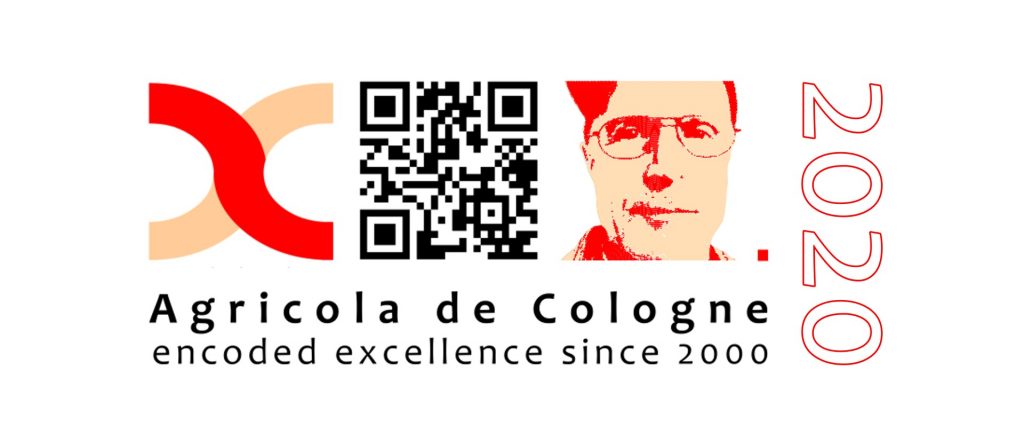The physical person behind
Agricola de Cologne was acting before 2000 as a visual artist under the name W.O.F Agricola, starting on 1. January 1980 after a periode of art related studies in Stuttgart, Munich and Amsterdam (1969-1978).
As an artist, W.O.F Agricola had two working phases – 1980-1989, the fall of the Berlin Wall is representing a fundamental break, the 2nd working phase – 1990-1998 is marked by two major projects – ARCHA Society 1990-1995, which can be considered as the starting point of curating, and the artistic Memorial, entitled: A Living Memorial Spaces of Art (1995-1998).
His artistic career was stopped and this art project destroyed by a terror attack in 1998. The artist W.OW Agricola died at the end of 1998 by falling in a several months lasting coma. The visual artist W.O.F. Agricola and his physical art work is remaining just as a shadow.
Physically born 1950 in Black Forest (Southern Germany), the artist started his carreer as an artist directly after his studies in 1980 as “W.O.F. AGRICOLA”, who died as such on 31.12.1998 as the result of a terrorist attack, to be reborn on 01.01.2000 as the brand and encoded artist “Agricola de Cologne” as the only true virtual artist and curator.
Studies
1969-1971 Stuttgart State Academy of Fine Arts (Grafic & Photography)
1971-1974 Munich University (Art History, Journalism and Dramatic Arts)
1974-1978 Rijksakademie Amsterdam (Painting)
Study sojourns
between 1985 and 2000 in Great Britain, France, Belgium, Italy, Russia, Lithuania, Latvia, Poland
residencies since 2000 in Brazil, Cuba, Latvia, Mexico
Since 1989, he realized several major collaborative and media related projects
1989-1995 Foundation of ARCHA Society- a temporary non -profit organization/cultural exchange between Western and Eastern Europe. As the President of ARCHA, Agricola organized several international conferences and cultural projects in Germany and Poland.
Since 1994 working with new technologies.
Between 1995 and 1999 realisation of the Memorial project
“A Living Memorial Spaces of Art” in 43 installations at 43 places in Germany, Poland and Czech Republic, including Krakow, Auschwitz, Terezin, Berlin, Hamburg, Cologne and others–>a complex of multi-media art works, including photography, video, computer and sound installations
1999 – physical recontruction after a many months lasting coma.
Agricola de Cologne
The artist rose from the dead, however. During a many years lasting physical reconstruction phase, he started a completely new physical and artistic life when he was launched on 1 January 2000 as Agricola de Cologne, an artist brand und virtual artist standing for the interdisciplinary media artist, creator of experimental films and videos, curator of media art, mediator, festival director, multi-media developer, programmer and designer of culture and much more. While his activities before 2003 were mainly virtual, the concepts of his activities after 2003 were focussed on the exchange between virtual & physical space.
Read more about the brand “Agricola de Cologne”
Behind Agricola de Cologne is standing a lot of biographical material, the conditions for initiating the “big bang” as an artistic action on 1 January 2000 out of itself.
Since its/his launch in 2000, Agricola de Cologne was presented @ more than 600 festivals and media art events in New York, Chicago, Los Angeles, Knoxville, Pittsburgh, Mexico City, Caracas, Maracaibo, Buenos Aires, Rosario, Montevideo, Rio de Janeiro, Sao Paulo, Belo Horizonte, Santiago de Chile, Quito, Bogota, London, Paris, Lyon, Toulouse, clermont -Ferrand, Marseille, Madrid, Gijon, Sevilla, Valencia, Barcelona, Lisbon, Athens, Thessaloniki, Nicosia, Valletta, Oslo, Bergen, Stockholm, Helsinki, Turku, Tampere, Copenhagen, Amsterdam, Rotterdam, Tokyo, Nagoya, Seoul, Manila, Hongkong, Bangkok, Phnom Penh, New Delhi, Kolkata, Guwahati, Mumbai, Jakarta, Perth, Melbourne, Addis Abeba, Casablanca, Rabat, Marrakesh, Istanbul, Ankara, Tblissi, Yerewan, Damaskus, Jerusalem, Tel-Aviv, Bethlehem, Gaza, Basel, Zurich, Vienna, Linz, Salzburg, Graz, Kiev, Kharkiv, Riga, Tallinn, Vilnius, Minsk, Moscow, St.Petersburg, Kansk, Perm, Yekaterinburg, Sofia, Varna, Bucharest, Arad, Timisoara, Budapest, Belgrade, Zagreb, Split, Lubljana, Rome, Naples, Milan, Pescara, Venice, Torino, Bologna, Berlin, Cologne, Düsseldorf, Karlsruhe, Nuremberg, & elsewhere, but also on biennials like ISEA Nagoya (2002), Venice Biennale 2003, 2005, 2007, Biennale of New Media Art Merida/MX 2003, Biennale of Electronic Arts Perth/Australia (2004), Biennale de Montreal (2004), Biennale of Video & New Media Santiago de Chile (2005), ISEA Singapore 2008.






